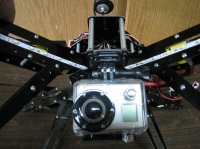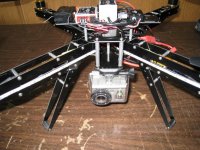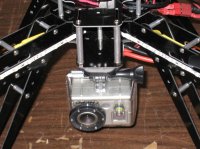You are using an out of date browser. It may not display this or other websites correctly.
You should upgrade or use an alternative browser.
You should upgrade or use an alternative browser.
GoPro Resolution
- Thread starter rwilabee
- Start date
DucktileMedia
Drone Enthusiast
Absolutely. Higher frame rates will show less jelloing. But you normally cant get rid of all of it just by increasing the frame rate. Better to isolate it all together. Good luck! it aint easy. I dont know what i did to get my video so perfect so i cant really help. Perhaps mass is the key.
Jellow effect is caused by the scanning system known as line skipping. by increasing the frame rate you effectively have less skipped lines. For shooting utube and Vimeo etc. I would go for Wide standard definition at 120 fps.
I don't normally spend so much time on the internet but my hard drive went down on my main power mac edit system. It has taken three days to reinstall everything. A virus for sure started the problem. Most data was backed up but a lot has gone for ever. I use a PC for internet most of the time.
I don't normally spend so much time on the internet but my hard drive went down on my main power mac edit system. It has taken three days to reinstall everything. A virus for sure started the problem. Most data was backed up but a lot has gone for ever. I use a PC for internet most of the time.
Last edited by a moderator:
DucktileMedia
Drone Enthusiast
that would be the first mac virus I have heard of. Sorry to hear that. And i dont think the Gopro 1 does 120fps. The gopro 2 does but in some unheard of crappy resolution. Isn't rolling shutter what causes the jello? In short CMOS sensors read from top to bottom( or other way around, cant remember) really fast. But unlike a CCD sensor that virtually captures the whole frame instantly, CMOS sensors will show any horizontal movement that moves faster than the sensor can grab the whole frame in before the movement. So by the time your scan line is at the bottom of the sensor, if your object has moved, you will see this as a horizontal line. Jello is basically the same thing only in a high enough frequency that it is "sine-waving" back and forth making things look jiggly.
Gunter
Draganflyer X4
From my experience, the jello effect comes from the camera being too loose on it's mount, or the mount rubbers are too soft. Please post some pics of your gimbal and how you have mounted the cam to the heli. It can probably be caused if the props aren't balanced as well, and the whole craft vibrates.
I have just tried my first video with the gopro mounted directly to the heli with no gimbal and there is no jello effect. It's just bolted straight to the frame.
Show us some pics and we can probably sort it out!
Gunter.
I have just tried my first video with the gopro mounted directly to the heli with no gimbal and there is no jello effect. It's just bolted straight to the frame.
Show us some pics and we can probably sort it out!
Gunter.
Droider
Drone Enthusiast
A virus for sure started the problem.
On a MAC.. Denny I aint questioning your experience but I have been on macs since 1986.. I have never had any anti virus software installed ever and have never had any problems which could be attributed to a virus.. on the other hand I have had scores of problems with windoze based laptops I use for work with more antivirus stuff on um than u can shake a stick at but still they have been corrupted by what the windowz guys call internet born malfunctions!
As with all reports of the dreaded jello affect I say it all starts with the props.. Check out the video I posted of my WMK quad.. the Gorpro was just bolted to the frame. Props were 10x5 Graupner electro streight from the packet, checked for balance with no adjustment needed... NO JELLO..
Last edited by a moderator:
DSLR cameras such as Canon produce a high resolution image. say around 21 mega pixels, there is no electronic means to transfer that amount of data at even 25 fps so what they do is skip some of the lines alternatively to bring it down to around 2 mp. In a slow moving sequence that is not seen however if you venture beyond talking heads then you will see moire and allaising problems and also rolling shutter jellow. With all types of camera the only solution is to keep the camera stable. My system can hold .005 deg. With a Wookgong M it is theoretically impossible to go beyond .05 with a slight lag, which is good enough for what most people will ever want. With post stab and camera stab. fixing the final output. What happens with certain Cmos cameras is the image stabilising system becomes confused by the vibration and then the image is displaced in the wrong direction. A lot of distortion in a GoPro comes from the very wide angle lens which is not linear. There is even a software filter to fix that.that would be the first mac virus I have heard of. Sorry to hear that. And i dont think the Gopro 1 does 120fps. The gopro 2 does but in some unheard of crappy resolution. Isn't rolling shutter what causes the jello? In short CMOS sensors read from top to bottom( or other way around, cant remember) really fast. But unlike a CCD sensor that virtually captures the whole frame instantly, CMOS sensors will show any horizontal movement that moves faster than the sensor can grab the whole frame in before the movement. So by the time your scan line is at the bottom of the sensor, if your object has moved, you will see this as a horizontal line. Jello is basically the same thing only in a high enough frequency that it is "sine-waving" back and forth making things look jiggly.
GoPro 2 has a stretched standard def mode at 120 fps what I said was that if your final goal is to produce vimeo etc. then why do you need HD. some of the slow-mo stuff on their video was shot that way. and then slowed down further in post.
I have six mac edit set-ups here and yes never had a virus before. The one that went down was the last of the G5 power mac non intel machines that is about six years old. Great machine but not able to run some of the later software. Repeated attempts to fix the directory only produced more problems until in the end no rescue was possible. I have the contents of the drive on a partitioned section on one of the raids but as yet only a handful of the 300 GB file have been saved.
Also have a couple of PC's as some of our software only works on that.
Last edited by a moderator:
Here are some pics of my setup and a you tube showing the jello effect. I have balanced my props. I wonder if my frame is not ridgid enough or if I have a motor shaft out of balance, no crashes to damage a shaft. I'm running good quality Scorpion motors.
View attachment 1389
View attachment 1391View attachment 1390
View attachment 1389
View attachment 1391View attachment 1390
From my experience, the jello effect comes from the camera being too loose on it's mount, or the mount rubbers are too soft. Please post some pics of your gimbal and how you have mounted the cam to the heli. It can probably be caused if the props aren't balanced as well, and the whole craft vibrates.
I have just tried my first video with the gopro mounted directly to the heli with no gimbal and there is no jello effect. It's just bolted straight to the frame.
Show us some pics and we can probably sort it out!
Gunter.
Attachments
Last edited by a moderator:
Gunter
Draganflyer X4
That gopro mount might be the problem. Try and move the camera and see if there's any play between the camera and mount. On all of my mounts, there is a bit of play. Try either a tripod mount with a screw from the top, or to start with, wedge a bit of cardboard between the camera mount and the other side, which is stuck to the frame. Ie hold the cardboard between the mounts as you are clicking them together.
Cheers, Gunter.
Cheers, Gunter.
I have absolutely no play in the mount. It is rock solid. I'm wondering where the the camera is picking up the vibration. It did the same thing with the cheapo motors before I got the scorpions so I don't think it is the motors. My blades are balanced. I'm just wondering if I have to much flex in the arms of the quad. If I grip the motors I can tweek the arms a bit when I rock left and right. I wonder if there is a camera that would handle it better than the GoPro. Maybe I need to buy a new Carbon Fiber frame from somewhere.
That gopro mount might be the problem. Try and move the camera and see if there's any play between the camera and mount. On all of my mounts, there is a bit of play. Try either a tripod mount with a screw from the top, or to start with, wedge a bit of cardboard between the camera mount and the other side, which is stuck to the frame. Ie hold the cardboard between the mounts as you are clicking them together.
Cheers, Gunter.
Last edited by a moderator:
DucktileMedia
Drone Enthusiast
I wondered that as well. I wonder if my video is massively better now due to the mount itself. Im using the AV130.
I would try to add some mass to the camera base plate in the first instance. You can get quite good results with the camera mounted solidly to the frame and that should get rid of those artifacts. You will of course not be able to correct the models pitch and roll accept though post stabilisation which can remove some of that. Do you want to have fun or produce top quality production work. If it's fun then mount it solidly to the frame. Some airframes do have a natural frequency oscillation that is always there.
Yes just have fun no top quality production work. I'll try adding some mass to the camera base plate and see what happens.
Thanks
Rich
Thanks
Rich
I would try to add some mass to the camera base plate in the first instance. You can get quite good results with the camera mounted solidly to the frame and that should get rid of those artifacts. You will of course not be able to correct the models pitch and roll accept though post stabilisation which can remove some of that. Do you want to have fun or produce top quality production work. If it's fun then mount it solidly to the frame. Some airframes do have a natural frequency oscillation that is always there.



